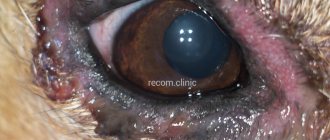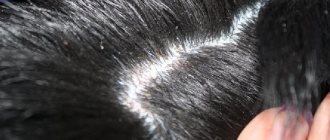Localization of papillomas in dogs
Papillomas are round formations of a pinkish tint with a smooth surface. Their growth is accompanied by darkening and a change from the original appearance to a rough one, reminiscent of a miniature cauliflower.
The location of papillomas determines their type:
- paw pads - pad;
- oral cavity, nose and lips – oral;
- thighs or lower body – multiple;
- abdomen and armpits – transitional cell;
- genital organs – genital;
- head or eyelids - cutaneous.
Young animals are more likely to suffer from the oral type of neoplasm, while older animals are more likely to suffer from multiple neoplasms.
Papillomas in a dog's mouth
How can you tell if your dog has ear pain?
There are the following symptoms of ear problems in dogs, which can help you determine your pet's condition.
- The dog begins to scratch his ears until they bleed.
- The dog's ear tissues are damaged and swelling occurs. It covers not only the passages, but also the tips of the ears.
- The ears begin to smell not very pleasant.
- In rare cases, pus is released.
- During a walk, the dog may tilt its head to one side.
- The ears become a source of pain. Any touch is accompanied by a plaintive howl.
These are just general symptoms of the disease. Any disease greatly suppresses the psychological state of a pet. He becomes irritable and can attack his own owner. But he can also become depressed and ignore commands.
A dog scratching its ears is a sign of ear disease.
Usually, when the owner comes home, he is joyfully greeted at the doorstep by the dog. But when no one greets you with a joyful bark, you should be concerned about the condition of your pet.
As you can see, ear disease is a very common condition that affects most dogs. Therefore, all owners should closely monitor the health of their pet. Now let’s take a closer look at what types of ear diseases there are in dogs.
Risk group and routes of transmission
The risk of infection is increased in:
- older dogs and puppies;
- animals with weak immunity, reduced due to a chronic disease or recent illness;
- pets belonging to pugs, cocker spaniels, spitz, miniature schnauzers and terriers.
The appearance of papillomas is due to:
- using a contaminated syringe during vaccination;
- interaction with personal belongings of an infected animal;
- direct contact with a sick dog;
- non-sterile instruments used for grooming.
Infection occurs from warts located on the cheeks and mucous membranes (lips, mouth).
If papillomas affect the ears, paws or neck of a pet, then it does not pose a danger to other animals.
As an animal ages, it becomes more susceptible to the virus.
Harmless reasons
There are options in which the appearance of a growth in a dog’s ear does not pose any danger:
- Blockage of the sebaceous glands. Provided that there is no inflammatory process, it does not cause any problems for the dog. When pressed, a white, viscous secretion comes out of the gland. Blocked sebaceous glands are not accompanied by pain, itching or redness. It can only become inflamed when infected. Most veterinarians are of the opinion that if the glands do not bother the pet, then nothing needs to be done.
- Dirt. There are breeds that have an anatomically complex ear structure, which leads to problems in caring for them. It is very difficult to care for the ears of English Bulldogs, Beagles, Basset Hounds and Cocker Spaniels. Owners of these breeds often experience growths in the ears of their dogs. They can be caused by the build-up of dirt. Only regular cleaning and treatment of the ears with antiseptic solutions and antibacterial ointments will help here.
- Injuries. The ear is one of the most common places that dogs injure. Such an injury can occur during a normal walk in the forest or in a quarrel with another dog. The wound quickly becomes covered with a crust and scars (if there is no suppuration). When palpated, it may seem that a growth has formed inside the ear. But, over time, the crust falls off and a small pink spot remains in its place.
Causes of papillomatosis
The main cause of the disease lies in the viral papillomavirus, which affects the skin and mucous bodies. Taking advantage of any microcracks, it penetrates into the body. The growth actively multiplies, capturing surrounding tissues and transforming them into tumors, and leads to chromosomal instability.
The virus is not always active after penetration. Sometimes it assumes a dormant state ranging from 7 to 60 days. Some animals do not notice the changes at all. In such cases, the incubation period lasts the entire dog's life.
Activation of the virus is provoked by:
- operations performed using general anesthesia;
- stressful situations;
- corticosteroids taken on a long-term basis.
papillomavirus
Despite the low risk of malignancy of the neoplasm, it is better to show an animal with papillomas to a doctor. Although the chances are small, degeneration into a cancerous tumor is quite possible.
Only dogs get sick with papillomavirus.
Humans and other pets cannot become infected from an infected animal.
Treatment at home
In some cases, it is not possible to contact a veterinary clinic immediately after detecting symptoms. But this is not a reason to leave a dog with wounds on the tips of its ears without help. There are several ways that can improve your pet’s situation before receiving qualified help:
- A regular pharmacy sells birch tar . You can lubricate the wounded area with it several times a day, this will protect the animal from infection and contribute to a speedy recovery.
- Tar can be replaced with Vishnevsky ointment , which has the same effect.
- Also, in order to protect the animal from infection and the spread of infection, it is necessary to wash the lesions with a solution of furatsilin , and then treat them with streptocide on top.
- If you know for sure that the wounds are the result of mechanical damage (a fight or an unsuccessful fall), then treat the damaged surface with hydrogen peroxide and anoint it with brilliant green.
- If you suspect an allergy, you need to review your diet. Until the exact cause is determined, exclude all cereals and most vegetables from your daily menu. Potatoes are considered especially dangerous.
All of the above measures will only help to avoid the spread of infection and deterioration of the animal’s condition. Even if they give a positive result, it will still be necessary to contact a veterinarian to determine the exact cause of the condition and prescribe the necessary treatment.
Dog ear growths can occur in any breed. These formations can be both harmless, not requiring treatment, and serious, which without urgent treatment lead to the death of the animal.
Treatment of formations is predominantly surgical. If they are benign in nature, they are excised without adjacent tissue. In case of cancer, not only the growth, but also the tissue around it is removed to prevent the preservation of pathological cells.
Symptoms of the disease
You can suspect something is wrong by:
- Lameness. When the paws are infected, it is difficult for a dog to make normal movements.
- Bleeding. The appearance of blood is a dangerous symptom inherent in a malignant formation. This sign also occurs when a sore is picked off while scratching, but only a veterinarian can find out the true cause.
- Unpleasant odor from the mouth. Injured papillomas attract harmful bacteria, leading to the appearance of suppuration.
- Excessive drooling. Sores accumulated in the oral cavity make swallowing difficult.
- Decreased appetite or a transition to exclusively soft foods, accompanied by a decrease in weight.
- Frequent attempts to bite into the paws. Interdigital papillomas cause a strong feeling of discomfort, forcing the dog to look for any way to eliminate the source of the problem.
Causes of nasal polyps in dogs
The cause of the appearance of benign formations in a dog’s nose is always difficult to determine. In particular, polyps can form due to:
- Inflammation of any origin.
- Viral infections of all types.
- Previous rhinitis, conjunctivitis or other infectious disease affecting the mucous membranes.
- Heredity.
- Temporary swelling.
- High blood pressure.
- Injuries, etc.
Diagnosis of warts on the body
It is impossible to do without a medical diagnosis, since the appearance of papillomas can lead to cancer.
Symptoms that are simple at first glance raise questions upon direct examination. For example, the detection of tumors in the female genital area is a real problem for the average person.
The following diagnostic procedures are used:
With insufficient immunity, a benign formation develops into a malignant one
Possible diseases
There are also diseases that the dog owner needs to become familiar with if he feels a hard or soft growth in his ear:
- Benign formations. Fibroids or lipomas, which can grow to the size of a small potato and close the entire ear canal. Such formations pose a danger only in case of aggressive growth. The risk of transformation into a malignant tumor is low. Surgical removal only at the discretion of the veterinarian (observation may be indicated if there is no active growth). They are soft to the touch and can roll under the skin when pressed. They do not hurt or ulcerate.
- Malignant formations. It mainly affects dogs over 7 years of age. The initial stage is characterized by the appearance of a small bone growth inside the ear, which constantly festers and bleeds. Pets suffering from chronic otitis media are at risk. At the initial stage, it is successfully treated surgically, but it can cost the animal’s life if the tumor grows into the submandibular lymph nodes.
- Papillomas. A common occurrence among dogs of all breeds. The older the pet, the greater the chance of papillomas appearing throughout the body. They often affect the auricle. In appearance they resemble small growths, predominantly flesh-colored or dark in color, located on the stem. There is a danger only when the number of formations exceeds more than 10 pieces in one ear. There is a risk of transformation into cancer, so it is recommended to remove all papillomas. This can be done using a laser or cryosurgery.
- Subcutaneous mite. The ears are a favorite place for demodex. A distinctive feature is multiple black growths, which the dog tries to pick out/comb out in any way, which leads to large scratching wounds in the muzzle area. Demodectic mange is difficult to diagnose at an early stage, as it can carefully camouflage itself under the fur, misleading the dog owner into thinking that it is just ordinary acne or dirt. Severe itching, wounds and the active growth of black formations at the site of the lesion are considered alarm bells. Treatment includes taking medications aimed at killing fleas and ticks (Symparica or Sanoderm).
- Cyst. A subcutaneous formation that occurs predominantly in adult dogs suffering from chronic ear diseases. Cysts often form from sulfur glands and accumulation of secretions. Removal only by surgery. An indication for surgery may be growth of the formation or a dangerous localization (if there is a risk of closure of the ear canal).
- Warts. Just like papillomas, they are of viral origin, but unlike them, they do not have a tendency to transform into cancer. They are more common in breeds with an abundance of folds (Shar Peis, English and French bulldogs, pugs). It is removed only if the wart is constantly injured and because of this can become an entry point for infection.
In conclusion, I would like to add that timely contacting a veterinarian with a suspicious growth in your dog’s ear can save his life.
Treatment of the disease and removal of papillomas
If the neoplasms are benign and do not bother the animal, then it is not necessary to remove or treat them. Treatment is carried out for dogs at risk and from an aesthetic point of view.
The therapy used is divided into:
Promptly
It is used in the presence of pain and severe discomfort. With this treatment:
Medication
Classic variation based on:
If the pet is in good health, the disease goes away on its own.
In this case, a repeated relapse is excluded, since the animal is equipped with immunity from papillomavirus.
It should also be noted that vaccination uses a sample of neoplasm tissue. The resulting vaccine is injected under the skin 2 times with a break of 7 days. Effectiveness becomes noticeable at the end of 1 month from the start of treatment.
Thus, for a complete recovery, the pet will need a month with vaccination, 2-3 months with drug therapy, and 1 month with surgery. Moreover, in the case of surgical intervention, the visible effect is noticeable immediately after the operation.
Basically, the disease occurs in a mild form and viral papillomatosis eliminates itself
How to rid your dog of warts
Typically, warts do not require treatment, but if the growth bothers your pet and does not go away on its own, it makes sense to remove it. Your veterinarian may suggest surgery or medication.
Drug treatments
The most popular treatment method is injections in combination with drugs to strengthen the immune system. Dogs are given injections of fosprenil with novocaine, gamavit, maxidin, salmosan. The injection is made at the base of the wart. Another option is intravenous administration of novocaine. The procedure will need to be repeated three times.
The most popular treatment method is injections of fosprenil with novocaine.
If papillomas do not go away within five months or more, they can be treated with retinoids. They contain vitamin A and effectively eliminate skin tumors. Medicines containing retinoids include podophyllin, teniposide, vincristine, doxorubicin and others.
Anti-verrucine paste is also used against skin growths. It should be applied to the papillomas and rubbed at least two to three times a day until the tumor disappears. To prevent the animal from licking the paste, the treated area is covered with a bandage.
Vaccination
Vaccination protects dogs from human papillomavirus and also reduces the risk of developing squamous cell carcinoma in infected animals. For injection, you can use an extract from a dog's wart.
Surgical removal
There are several ways to remove warts on dogs.
Surgery is usually used for single tumors. The disadvantage of surgical intervention is that there is a possibility that viral particles will be introduced into the wound and papillomas will begin to grow with a vengeance. Therefore, after removing warts, you need to monitor for possible complications. If after 3 months everything is fine, then the operation was successful.
Modern veterinarians use more than just a scalpel. A wart can be removed using radiosurgery, electrocoagulation, diathermocoagulation and other methods.
Cryotherapy is the “freezing” of a tumor, which stops the metabolism in the affected tissues. Exposure of the wart to liquid nitrogen or dry ice is used for keratinized growths on the skin. Cryotherapy is effective for tumors in the eye area. The disadvantage of the procedure is its pain. Most likely, several procedures will be required, spaced three weeks apart.
A wart can also be removed using a laser. Typically this method is used for malignant tumors.
Folk remedies
Warts can be eliminated at home using traditional methods. The most radical type of intervention is to remove the tumor using scissors or thread. This procedure can lead to complications: bleeding and infection of the wound.
If the wart has appeared recently, then you can try to cure it with folk remedies, dandelion juice.
If the papilloma has appeared recently and has not yet grown, you can stop its development with the help of dandelion or celandine juice. After the surface of the new growth darkens, you can cut it off. Warts can also be smeared with iodine. In most cases, they disappear within a week. Another option is to lubricate the new growths with garlic juice. Old warts can be cauterized using a lapis pencil or acetic acid.
Attention! Home treatment is dangerous because it can provoke the degeneration of a benign tumor into a malignant one. In addition, not every owner can correctly determine the type of rash on a pet’s skin.
Complications of the disease
Papillomas can degenerate into malignant tumors, but the risk of such an outcome is low. It is also important not to trigger the disease in dogs at risk. Due to low immunity, it is more difficult for them to survive the disease.
Against the background of papillomavirus, secondary fungal and bacterial infections develop. Abrasive sores in the oral cavity can lead to stomatitis.
Despite the acquired immunity, the recovered dog becomes a carrier of the virus and poses a danger to animals at risk.
Characteristics of the problem
Ear disease is one of the most common problems found in dogs. Most often, swelling of these organs is observed in breeds that naturally have long and large ears. Therefore, owners of dachshunds, basset hounds and Afghan hound puppies should carefully monitor their pets to notice the problem at an early stage.
The tissue in the inner, outer, or middle ear may become swollen. Often the true cause of this phenomenon can only be identified by a specialist, so do not neglect a visit to the veterinarian.
The main reasons why the ear may swell:
- otitis;
- hematoma;
- allergy;
- abscess;
- growths;
- water getting into the ear;
- foreign objects entering the ear canal.
The main danger of a dog having swollen ears is the risk of developing severe complications that pose a danger to the animal’s life. There are known cases of ear diseases leading to inflammation of the membranes of the brain. Tissue swelling can also cause rupture of a pet’s eardrums and deafness.
Caring for a sick dog
Adherents of traditional medicine advise using:
- garlic;
- spurge;
- dandelion;
- celandine;
- dry ice;
- rowan;
- linen threads and other options.
Wart on a dog
The use of such techniques increases the risk of developing fibrosarcoma, and the use of folk remedies on the mucous membrane of the eye can permanently deprive the pet of vision.
After removing the tumor, wait for complete healing. Treat the area with medications recommended by your doctor until the crust falls off on its own. As a rule, dietary adjustments are not required, but in case of damage to the oral cavity, it is better to temporarily switch to soft and liquid foods.
During treatment and care, purchase a special collar.
In it, the dog will not be able to lick off the ointments used.
Types of warts
Warts in dogs vary in color, size and location. They can occur anywhere on the animal’s body, but most often they affect the limbs, back, head, mouth, lips, and ears. The rashes can be single or numerous, resembling clusters.
Warts can range in size from tiny “pimples” that are barely noticeable on the skin to bean-sized tumors. The color can be pink, brown, yellow, grayish-black.
Photo. Papillomas in a dog's eye
Photo. Warts on a dog's lip
New growths can be hard or soft to the touch. Hard warts have a smooth surface and a convex shape, while soft warts are flatter and rougher. The neoplasm can be embedded deep into the skin or rise on a thin “leg”.
Important! Warts that grow quickly and become dark in color may be carcinomas (malignant neoplasms). This type of rash requires immediate attention to a veterinarian.
What can papillomas be?
Papillomas in dogs have a distinctive feature - they do not grow inside the tissues, but develop exclusively outside. The virus infects only the upper layers of the skin or mucous membrane. The following types of papillomatosis are distinguished:
- Papillomas in the oral cavity. Usually this type of virus sticks to young animals. It is transmitted from a sick dog to a healthy one through shared toys or through direct contact as a result of play. Affects the mucous membrane of the oral cavity, lips, nose. Papillomas are gray or white, up to 1 cm in size. This type of papillomatosis is contagious. That is, if your pet is infected with it, then it can infect other dogs. Important point! A person cannot become infected with this virus from a sick animal.
- Transitional cell papillomas are also found mainly in young dogs. In appearance, they resemble a small round-shaped lesion, consisting of many short growths and resembling a sponge in structure. This type of papillomatosis mainly affects the surface of the abdomen or axillary areas.
- Skin papillomas - on the skin and paws are found mainly in older animals. Almost always these are benign single neoplasms that have a dense structure and grow very slowly. Usually, skin papillomas look like small formations, up to 1 cm in size, not covered with hair, and in appearance they really resemble a tick that has sucked blood. Such papillomas are more detrimental to the appearance than to the health of the animal. However, if they are located on the paws, then when they come into contact with the ground, they may hurt and bleed.
- Pigmented papillomas occur mainly in small breed dogs. Appear on the lower part of the body. They are distinguished by a dark shade and resemble a match head on a thin stem. In an advanced form, warts become multiple and scaly.
- Genital papillomas are very rare and in appearance resemble small single growths.
If you find a “strange” growth on your pet’s body, make sure that it is not a tick, or, as funny as it may sound, that it is not a nipple.
At one time, out of inexperience, I myself mistook my Jack’s nipple for a wart!
How dangerous are dog warts?
Oddly enough, their danger is somewhat exaggerated, and many veterinary publications are often involved in “pumping up” them. Cases of spontaneous remission of the disease are often recorded, since the dog’s body can defeat the virus on its own. Indeed, warts on the body sometimes develop into cancer, but this rarely happens. There is evidence that papillomas around the eyes are the most “durable” and are least likely to undergo spontaneous remission.
Recently it has become clear that papillomatosis in dogs in the ears and, for example, on the eyelids, is sometimes caused by different types of pathogens. Simply put, one of the warts may be completely harmless, while the second wart has a tendency to turn into something malignant. Sometimes papillomas in the oral cavity turn into a “springboard” for the development of some kind of oral infection. In this case, the smell from the dog’s mouth becomes extremely unpleasant and putrid, and saliva constantly flows from there.











